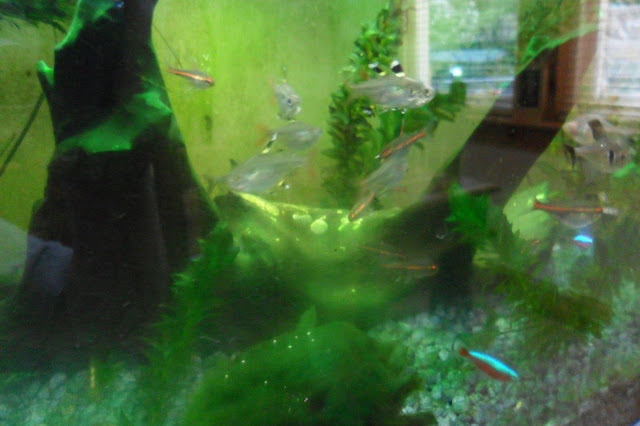In chess they say it's better to have a bad plan than no plan at all. I thought I would try cutting off the direct sunlight the tank got ( it only got one or two hours a day but I pinned all my hopes on this at the time) and then dosing with antibiotics. In week 57 I installed blackout blinds over the skylights and in week 58 dosed. I gave up adding nutrients, it had been a waste of time and the plants were losing anyway. I just cleaned the gravel and plants and did weekly water changes. As before, back came the hair algae. It seemed like the algae and cyano were in direct competition because knocking the cyano out always caused the algae to grow well. I'll return to this point in a later post. Below are two stills from a video shot in week 62
 |
| Week 62. |
The bogwood is covered in hair algae (and cyano) but you can see the gravel is dirty, it was amazing how much fs had built up. The bubbles on the back wall are trapped by the cyano sheet covering the hair algae, this is the cyano equivalent of 'pearling'. So the cyano came back within four weeks, I thought maybe it was getting resistant to the antibiotics and decided to give them up. It was also clear that direct sunlight was not a factor.
From reading the forums it seems that there is an association between localized cyano patches and direct sunlight. The posts are unusual in that the authors often quote their direct experiences. They say things like "I had cyano in my gravel at the front of the tank and it went away after I put black tape over it" or "it goes away if I clean that patch of gravel regularly". I can back this up.
This is a photo of my unheated golfish tank taken recently, it's in a different room but on the same side of the house as the tropical tank. In that bottom corner against the glass is the unmistakable sign of cyano. And that corner gets the most of the one or two hours of direct sunlight. But this is very different to what I'm talking about. The cyano only grows in this corner of the tank and this is four weeks after a water change. It never takes over like it does in my tropical tank. I will examine this cyano under a microscope and report back, could be interesting.
Back in week 62 I decided it was time to simply accept cyano as my companion.














